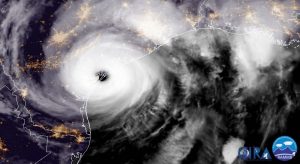Hurricanes Harvey and Irma have proven to be catastrophic disasters for the residents of southeast Texas, the Florida Peninsula and Puerto Rico. Which adaptive actions are needed to mitigate the potential societal impact of the anticipated heightened intensity of storms like Harvey and Irma? A few suggestions are offered below.
- Forecast system: Hurricane Harvey and Maria’s devastating impacts were well forecasted days in advance, while Irma was a challenge due to the state’s geography. The National Hurricane Center has made significant progress in recent years in forecasting the tracks of hurricanes, which provides state and local governments with advance warning of landfall location, arrival of winds, storm surge and flooding. Understanding how hurricanes can impact coastal populations in the near to long term can influence building codes, the insurance market and conservation efforts. The value of better forecasts is relative to the affected populations, however, so advances in communicating the dangers of extreme events remains a challenge.
- Policy: One of the key lessons of this hurricane season’s legacy is the impact on rebuilding cities like Houston, San Juan, Key West and other affected areas. Policy-makers will need to consider the very real possibility that heavy rainfall events are becoming more common. This will likely affect emergency management, zoning regulations, drainage systems, hazardous materials, levee construction and liability. Thus, a thorough review of environmental policy will need to occur to begin addressing our vulnerability to extreme events, especially as they become more severe due to climate change.
- Communication: The storms’ multi-faceted effects, from high wind damage to devastating floods are tangible impacts of nature’s impact on society. Climate science has shown us that one of the impacts of climate change is the advent of stronger, more frequent extreme events. Harvey and Irma’s impacts provide a chance for breaking through the barrier of climate literacy to show how global warming affects people in their own backyards.
- Geographic Information System: Flood risk maps, population density, storm surge mapping are some key elements that provide guidance for emergency management, insurance, and the general population about the impact of severe weather. Harvey and Irma have shown how this capability can be used to save lives and protect infrastructure. It also shows how these systems need to be updated in terms of the available data and mapping capabilities and techniques so that we may have better in situ knowledge of how extreme events will impact us in the future.
- Public Health: The record-breaking amount of water and storm surge that was unleashed by Harvey, Irma and Maria greatly impacted the public health systems. Hospitals were flooded and access to emergency services was limited due to the continuing rainfall. The effects will linger due to pollution of the water and proliferation of waterborne diseases as well as mosquito infestation. Public health systems will rely on upgrades to their infrastructure and timeliness of response, as well as education on interface of climate change and the health sector in order to provide resiliency to the system.

